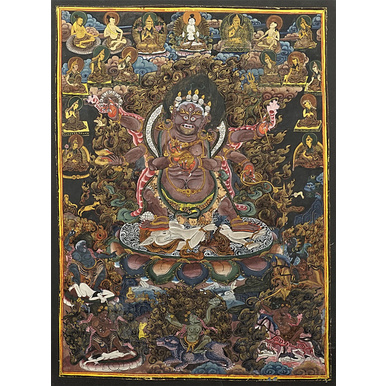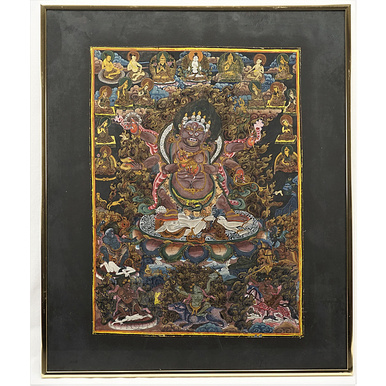

Thangka des Mahakala, Tibet / Nepal
Papier, Schwarzgrund, polychrom und mit Goldfarbe bemalt; zentrale Figur ist der zornige Beschützer des Buddhismus (Verbindung zu Avalokiteshwara, dem Bodhisattva des Mitgefühls), mit sechs Armen, in seinen Händen hält er u.a. eine Gebetskette aus Totenköpfen (mit der er unablässig zum Wohle aller Wesen Mantren rezitiert), eine Schlinge (mit der er alle Feinde fesselt, aber auch den Praktizierenden selbst an seine Gelübde bindet) und einen Dreizack (trishula, symbolisch für Buddha, die buddhistische Lehre und die Gemeinschaft), steht auf einem Elefantenwesen, welches für weltliche Orientiertheit, aber auch für den ungezügelten Geist steht; diese Todessymbole werden bewusst eingesetzt, um die Menschen, welche sich vor dem Tod fürchten, den wahren Tod zu lehren – den Tod des Ich; Mahakala lässt das kleine Ich erschauern, auf dass es den Kampf gegen seine wahre Natur aufgebe und sich der Einheit allen Seins beugen kann; umgeben von weiteren Bodhisattavas, sehr guter Zustand, 47 x 34 cm (HxB)
Thangka of the Mahakala, Tibet / Nepal, paper, black ground, polychrome and painted with gold paint; the central figure is the angry protector of Buddhism (connected to Avalokiteshwara, the Bodhisattva of compassion), with six arms, in his hands he holds, among others, a prayer chain made of skulls (with which he ceaselessly recites mantras for the benefit of all beings), a noose (with which he ties all enemies, but also ties the practitioner himself to his vows) and a trident (trishula, symbol of Buddha, the Buddhist teaching and the community), stands on an elephant being, which stands for worldly orientation, but also for the unbridled spirit; these death symbols are consciously used to teach people who fear death about true death - the death of the self; Mahakala makes the little ego shudder so that it can give up the fight against its true nature and bow to the unity of all being; surrounded by other bodhisattavas, very good condition